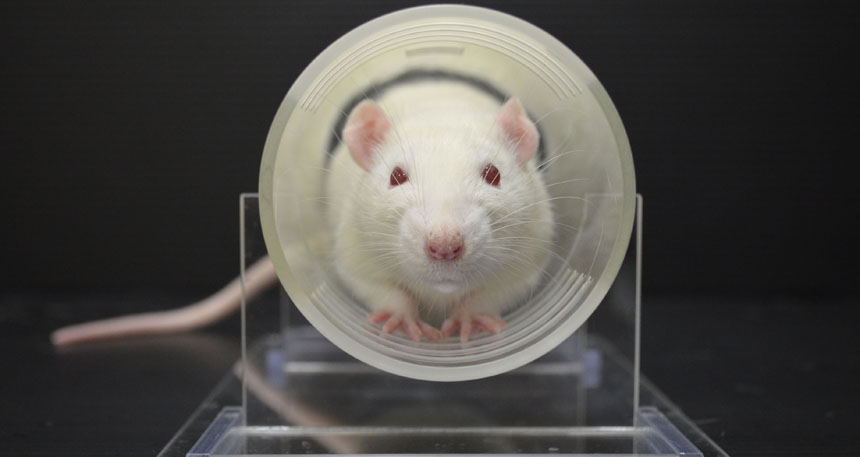The scent of a worry
Rats release a chemical signal that makes other rats fret

This rat is in a small tube that will measure how much it jumps in response to a surprising tone. Exposure to a specific two-chemical combo from other rats will make it anxious — and liable to larger leaps.
Y. Kiyokawa
- More than 2 years ago
Rats stink. First there’s the poop smell and the urine. And then there’s just that smell of rat — a kind of dusty, hairy little smell. But it turns out that rats don’t smell quite the same all the time. When they are stressed, they produce a different odor, one that makes other rats anxious.
Now, Hideaki Inagaki and colleagues at the University of Tokyo in Japan have isolated the particular stress-related odor and identified the two specific chemicals behind it. The results reveal the first evidence of an isolated anxiety pheromone in rats, and give reason for scientists to look at — or maybe sniff — their behavioral experiments cautiously. And the findings could also offer glimmerings of a new flavor of rat-be-gone.
Pheromones are chemicals that give off distinct odors that allow an animal to communicate within its own ranks. In rats, as in many other animals, many pheromones activate the vomeronasal organ, a small patch of cells at the base of the nasal cavity. Other researchers have found evidence of pheromones in maternal behavior and in the response of rat pups to their mothers.
In the new study, the pheromones in question are about alarm and anxiety. Study coauthor Yasushi Kiyokawa of The University of Tokyo says he first came across the alarm odor when he was a graduate student. “I noticed the rats released a specific odor when I handled them for the first time, as they were stressed by the novel handling procedure,” he recalls. He went sniffing to find the source. “I found that the intensity of the odor was strongest around the anal region,” he says. Many mammals have glands around the anus that produce oils and odors. Since that first whiff of a clue, Kiyokawa and colleagues at the University of Tokyo have been working with what they called the “alarm pheromone.”
While rats may be smelly to some, Kiyokawa says this particular smell isn’t unpleasant. “Like a hay or dried grass,” he says. “At least for me.”
To isolate the two chemicals responsible for the odor, the scientists used a test called acoustic startle. A loud, unexpected sound will always make a rat twitch. But when a rat is feeling anxious, it will jump a lot higher in response to the sound. Inagaki and colleagues found that two specific chemicals, 4-methylpentanal and hexanal, work in concert to increase acoustic startle responses in male rats. Anti-anxiety medications blocked the effect, and so did removal of the vomeronasal organ. The mixture of the two chemicals also activated neurons in an area of the brain that plays a role in anxiety, the researchers report December 15 in the Proceedings of the National Academy of Sciences.
4-methylpentanal and hexanal only worked togetherand did not induce anxiety on their own. Coby Schal, a chemical ecologist at North Carolina State University in Raleigh, hypothesizes that hexanal could be one of the chemicals that induces rat anxiety because it is a common chemical emitted by predators and parasites. “It is a common compound of urine, including in carnivores (cheetah, for example),” he explains. Rats could have evolved to include hexanal as part of anxiety-related signaling between rats, he suggests.
Rat social messaging could be very important for scientists to keep in mind as they study behavior. Many scientists studying rodent behavior run tests that are stressful to the animals, with wide open spaces, heights or bright lights that rats don’t appreciate. The animals leave the scents of their anxiety, along with the more physical evidence of their poop or pee, behind after an experiment is done. Before the next experiment, a scientist will clean out the chamber, often using an ethanol solution to remove both smells and the droppings of the previous occupant.
But Robert Hallock, a taste and smell researcher at Skidmore College in Saratoga Spring, N.Y., notes that we don’t actually know how much an ethanol wipe-down leaves behind. “I would hope this is an eye-opener to the average researcher,” he says. “They have to keep in mind that a rat lives in an olfactory world like we live in a visual world. There are chemical signals we aren’t aware of.”
Kiyokawa agrees that paying close attention to the odor left in the apparatus after experiments could help reduce variability between animals during testing. He also says that learning more about rat pheromones will help scientists better understand how rats communicate with each other.
But Kiyokawa also has hopes that understanding what’s in the pheromone mixture will be useful on its own. He’d like to someday use pheromone technology to help control pests. The chemical mix they studied doesn’t appear to repel rats, but he’s hopeful that further understanding of pheromones could help scientists synthesize mixtures to harmlessly ward off pests. All you need is a small dose of the right kind of fear.





